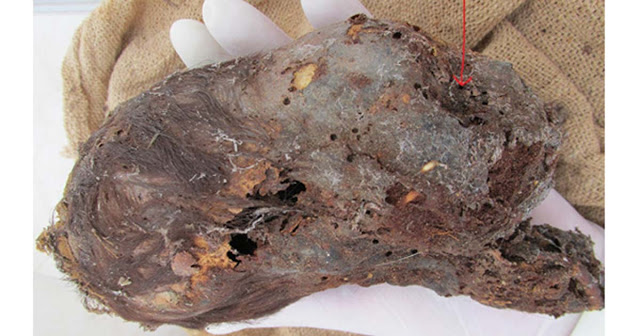(Ivan) One of the most fascinating ancient elongated skulls has just been discovered. According to Brien Foerster over at hidden Inca Tours, the mummified head and partial neck of a baby from the Paracas culture of Peru is one of the most amazing elongated skulls discovered to date. This mysterious skull has auburn hair color which is not the typical black color seen in Native American People.
Related Discernment Lesson | Researchers Test Paracas Elongated Skulls and Conclude “We are dealing with a completely new human-like being”
Source – Ancient Code
by Ivan, January 19th, 2017
It is believed that the elongated skull dates back to around 2,800 years, most likely belonged to a newborn, or perhaps 3-month year old baby.
What makes this elongated skull so unique?
Well, according to experts, this mummified elongated skull is suggestive of a genetically elongated skull, meaning that it isn’t the result of head binding, since the process of artificial cranial deformation takes at least 6 months to produce the desired effect.
Buy Book Aftershock: The Ancient Cataclysm That Erased Human History by Brian Foerster
So far, archaeologists in Peru have found hundreds of elongated skulls with peculiar characteristics. This new discovery hints at the possibility that thousands of years ago, an ancient race of people lived in Peru with naturally elongated skulls.
Furthermore, Brien Foerster points out the ‘very fine hair’ of the baby, which curiously is auburn red in color, and not the typical black color seen in Native American People.
| The red arrows indicate the position of the eye sockets and the mouth. Image Credit: Brien Foerster Hidden Inca Tours |
In addition to the auburn hair color and freakishly elongated skull, Brien Foerster notes that the vertebral column of the baby is located further back from the skull than in normal humans which “could well indicate an evolutionary adaptation to compensate for the elongated skull”.The Paracas elongated skulls have been the subject of debate among experts for years.In 1928 researchers found on the southern coast of Peru a cemetery that held the remains of 300 individuals with elongated skulls. The discovery was led by Peruvian archaeologist Julio Tello, and it is believed that the skulls may date from about 3,000 years ago. These are known today as the “Paracas skulls”.
Strangely, the volume and weight of the skeletons is anything but normal. According to researchers, the cranial volume of the “Paracas Skulls” is up to 25% larger and 60% heavier than conventional human skulls. And there is more to the mysterious skulls. The human skull is composed of two parietal bones located between the frontal and occipital, forming the sides of the calvaria. The calvaria or also called skullcap, is made up of the superior portions of the frontal bone, occipital bone, and parietal bones. The “Paracas Skulls” only have one.
Interestingly, it seems that Elongated Skulls are a global phenomenon. The elongated skulls phenomenon is not isolated, evidence of this are the countless skulls that have been discovered in all corners of the globe.
The head binding phenomenon has become one of the most puzzling subjects for archaeologists around the globe who seem to avoid, at all cost, exploring the tens of thousands of elongated skulls discovered around the globe: Mexico, Peru, Bolivia, Egypt and even parts of Asia.
Source: Hidden Inca Tours
Ivan is a freelance writer, editor-in-chief of ancient-code.com, he also writes for EWAO, Share Knowledge, Svemir Online and Ancient Origins.
History, Archaeology, Space and world’s mysteries are some of the topics he writes about.
Not sure how to make sense of this? Want to learn how to discern like a pro? Read this essential guide to discernment, analysis of claims, and understanding the truth in a world of deception: 4 Key Steps of Discernment – Advanced Truth-Seeking Tools.
Stillness in the Storm Editor’s note: Did you find a spelling error or grammar mistake? Send an email to [email protected], with the error and suggested correction, along with the headline and url. Do you think this article needs an update? Or do you just have some feedback? Send us an email at [email protected]. Thank you for reading.

Leave a Reply